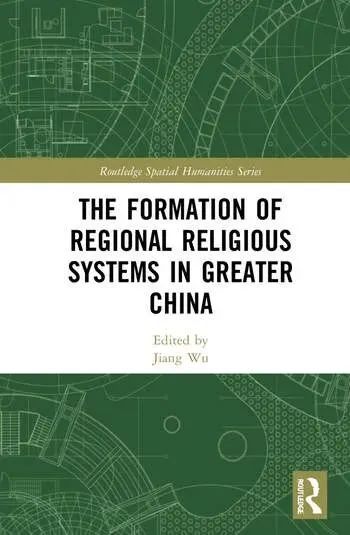作者:吴疆 发布时间:2022-05-06 来源:复旦发展研究院+收藏本文

Jiang Wu (ed.), The Formation of Regional Religious Systems in Greater China, London: Routledge, 2022.
Book Description
The rise of Spatial Humanities has spurred a digital revolution in the field of Chinese studies, especially in the study of religion. Based on years of data compilation and analysis of religious sites, this book explores the formation of Regional Religious Systems (RRS) in Greater China in unprecedented scope and depth. It addresses quantitatively the enduring historical and contemporary issues of China’s deep-rooted regionalism and spatially variegated cultural and religious landscape.
A range of topics are explored: theoretical discussions of the concept of RRS; case studies of regional and local religious institutions; the formation of local cults and pilgrimage network; and the spread of religious networks to overseas Chinese communities and the Bon religion in Tibet. The book also considers long-standing challenges of researching with spatial data for humanities and social science research, such as data collection, integration, spatial analysis, and map creation.
This book will be of interest to students and scholars in Religious Studies, Cultural Studies, Chinese Studies, Digital Humanities, Human Geography and Sociology.
Table of Contents
Dedication
Acknowledgment
Preface by Lewis Lancaster
List of Major Chinese Administrative Regions
Chronology of Chinese history
Introduction: Exploring Regional Religious Systems (RRS): Theoretical and Methodological Considerations
Jiang Wu
Part One: RRS and the Spread of Religious Sites in Medieval China
1. Making and Marking Buddhist Sacred Space: Wuyue Buddhism and Its Influence in the Song Dynasty (960–1279)
Albert Welter
2. On the Spatio-temporal Analysis of Religious Institutions: A Study of the Jinhua Prefectural Gazetteer of 1480
Peter K. Bol
Part Two: RRS and the Buddhist Pilgrimage Network in Late Imperial China
3. Traversing the Pilgrimage Square of Northern China in the 19th Century
Marcus Bingenheimer
4. The Ways of Traveling: A Historical GIS Examination of the Pilgrimage Routes Centered on Mt. Jiuhua in Late Imperial China
Nan Ouyang
5. Regional Systems of Guany in Pilgrimages in the Lower Yangtze Delta during the Ming-Qing Period (1368–1912)
Weiran Zhang and translated by Nan Ouyang
Part Three: Regional Analysis of Modern and Contemporary Chinese Religions
6. Mapping the Growth of Early Yiguandao Buddha-halls
J. E. E. Pettit and Joey Marshall
7. Churches at the Margin: Mapping the Establishment of Protestant and Catholic Churches in China, ca. 1949–2004
Fenggang Yang, Joey Marshall, and J. E. E. Pettit
8. Spatio-temporal Analyses of Changing Religious Landscapes in China
Shuming Bao and Yexi Zhong
Part Four: Regional Formation in Periphery
9. Historical GIS and the Study of Southeast China and the Southeast Asian Chinese Diaspora
Kenneth Dean
0. Using Geospatial Technologies to Study Regional Folk Religions: The Taiwan Religion Database and Two Case Studies
I-chun Fan, Ying-fa Hung, Hsiung-ming Liao, Jr-jie Jang, Chien-chou Chen
1. A Regional Systems Approach to the Origin and Spread of the Bon Religion of Tibet
Karl E. Ryavec
Editor(s)
Biography

Jiang Wu director, Center for Buddhist Studies and professor, Department of East Asian Studies, College of Humanities, The University of Arizona, USA.
吴疆,1994年南开大学中国哲学专业硕士,2002年美国哈佛大学宗教学博士,师从杜维明与詹密罗 (Robert Gimello)教授,专治十七世纪中国宗教思想史,现为美国亚利桑那大学佛教研究中心主任、东亚系教授。吴疆佛教研究的领域主要有:前近代中国佛教的复兴、汉文大藏经的形成和演变、中国佛教对前近代日本的影响、中国寺庙数据库与区域宗教系统的空间分析等。吴疆教授曾于2018年4-5月在复旦大学中华文明国际研究中心从事访问研究,本书是他在中心访问期间展开的持续推进的成果。